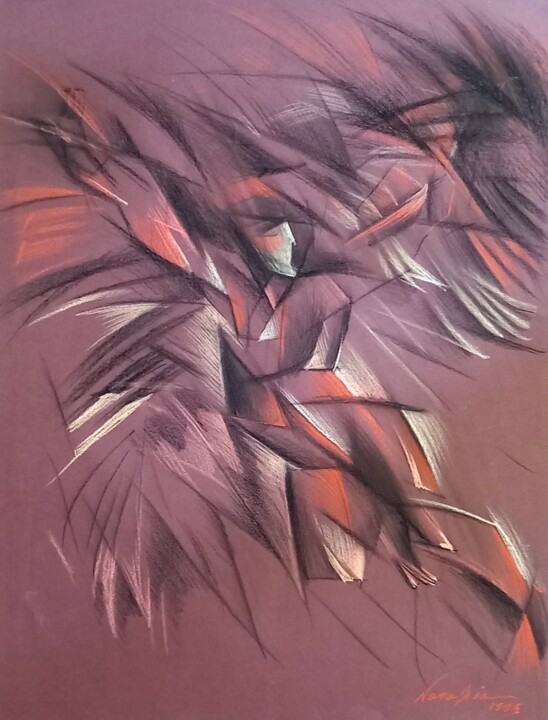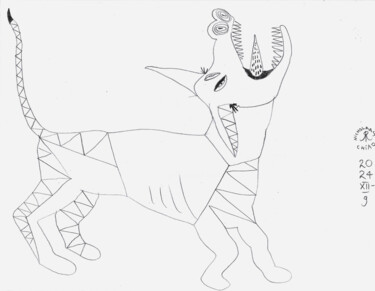379 原始图纸和插图出售:
你在找出售原始图纸吗?
探索所有绘画风格和技巧:当代艺术、街头艺术、抽象艺术、具象艺术、风景、肖像、生活场景、裸体、铅笔、墨水、木炭、粉彩…… 20 年来,有超过 360 万件当代艺术作品等待您去发现……或获得!艺术设计的世界标杆。发现来自世界各地的当代艺术家的作品,用一流的方式装饰您的室内!单纯的艺术爱好者还是公认的收藏家?找到真正突出您的装饰的图画或最喜欢的草图。 ArtMajeur 为您提供世界上最优秀的当代艺术家的原创作品、限量版和艺术版画。在 ArtMajeur 上,图纸是由艺术市场的爱好者和专家挑选的。我们为您精选时尚、屡获殊荣的知名设计师的原创作品以及当代艺术领域的新兴价值,为您在线购买艺术画作提供指导和帮助。
Discover contemporary Cubism Drawings on ArtMajeur
Contemporary Cubism drawings are known for their use of geometric shapes and bold lines, creating a sense of fragmented reality.

©1995 Natalia Kaza
Origins and History
Contemporary Cubism drawings originated in the early 20th century in France. Pablo Picasso and Georges Braque are considered the founders of this art movement, which aimed to break down traditional forms and perspectives in art. Cubism drew inspiration from African and Oceanic art, as well as the works of Paul Cézanne. The movement is characterized by the use of geometric shapes, fragmented forms, and multiple perspectives in a single image. Cubism was popularized during the 1910s and 1920s, and had a significant influence on other art movements such as Futurism and Surrealism. Contemporary Cubism drawings continue to be created today, with artists exploring varying levels of abstraction and experimentation with form. Questions surrounding the nature of perception and reality continue to inspire and challenge contemporary artists working within this style.

©2022 Mr Foe'Z
Evolutions of theses works in the contemporary art market
Contemporary Cubism drawings have been evolving in recent years, with artists experimenting with new techniques and styles. These works are particularly important in the contemporary art market, where they are gaining popularity and demand. Some of the key features of contemporary Cubism drawings include the use of vibrant colors, bold lines, and geometric shapes.

©2023 S C H A S C I A
Related Famous Artists
Contemporary Cubism is a style that has captured the imagination of many artists in recent times. Here are some well-known artists who have made a name for themselves with their works in contemporary Cubism.
Georges Braque - Braque was a French painter who, along with Pablo Picasso, developed the Cubist style of art in the early 20th century. He is known for his use of fragmented forms and multiple perspectives in his paintings.
David Hockney - Hockney is a British artist who is known for his vibrant and colorful paintings, many of which have a Cubist feel to them. He often uses multiple perspectives and fragmented forms in his works.
Juan Gris - Gris was a Spanish painter who was one of the leading figures of Cubism. He is known for his use of flat, geometric forms and his bold use of color.
Pablo Picasso - Picasso was a Spanish painter who is widely considered to be one of the most important artists of the 20th century. He is known for his innovative use of form and his development of the Cubist style of art.
Robert Delaunay - Delaunay was a French painter who was one of the pioneers of Cubism. He is known for his use of bold, bright colors and his exploration of the relationship between color and form in his works.
These artists have all made significant contributions to the development of contemporary Cubism, and their works continue to inspire and influence artists today. Whether through their use of fragmented forms, multiple perspectives, or bold colors, they have created a style of art that is both innovative and timeless.

©2023 S C H A S C I A
Notable contemporary Cubism Drawings
Cubism, a revolutionary art movement, emerged in the early 20th century and continues to inspire artists today. Here are some well-known contemporary Cubism drawings:
"Les Demoiselles d’Avignon" by Pablo Picasso, created in 1907, depicts five nude women with distorted faces and bodies. This artwork is considered one of the most significant Cubist paintings, as it challenged traditional Western art and inspired future artists.
"Three Musicians" by Pablo Picasso, created in 1921, portrays three figures playing instruments. The painting features bold colors and geometric shapes, epitomizing Cubism’s abstract style.
"The Portuguese" by Georges Braque, created in 1911, depicts a man playing a guitar. The painting features fragmented shapes and multiple viewpoints, characteristic of Cubism.
"Violin and Candlestick" by Georges Braque, created in 1910, shows a violin and a candlestick on a table. The painting features overlapping shapes and muted colors, creating a sense of depth and dimension.
"Still Life with Chair Caning" by Pablo Picasso, created in 1912, is a mixed media artwork featuring a chair caning pattern and a painted image of a pipe. The artwork challenges the traditional boundaries of painting and sculpture, reflecting the Cubist movement’s innovative spirit.
These contemporary Cubism drawings exemplify the movement’s emphasis on abstraction, multiple viewpoints, and fragmentation. They continue to inspire artists and art lovers today, showcasing the enduring influence of this revolutionary art style.

S C H A S C I A
铅笔在纸上 | 30x21 in

Iana Cherepanska
墨在纸上 | 6.3x4.3 in


































